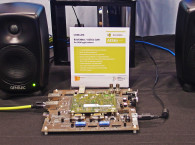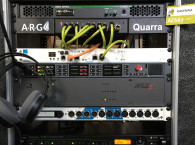 As this month’s editorial states, with each passing month, audioXpress is closer to becoming a reference information source for innovative solutions and technologies in audio electronics, acoustic, and electro-acoustic design. Increasingly, “a must-read for R&D and product design projects,” audioXpress April 2016 clearly shows evolution with lots of great articles to match its readership’s specific interests.
As this month’s editorial states, with each passing month, audioXpress is closer to becoming a reference information source for innovative solutions and technologies in audio electronics, acoustic, and electro-acoustic design. Increasingly, “a must-read for R&D and product design projects,” audioXpress April 2016 clearly shows evolution with lots of great articles to match its readership’s specific interests.Our April 2016 cover highlights the fourth installment in our series dedicated to Audio Network Development and implementation in new audio products. This month we discuss developing audio products based on RAVENNA, an open media network technology, available without a proprietary licensing policy, which is also at the forefront of the interoperability efforts with AES67.
audioXpress previously published two articles describing RAVENNA in detail (both articles are now available online). Since audioXpress published those two articles, the new AES67 standard for high-performance streaming audio-over-IP (AoIP) interoperability became a practical reality. Together with Livewire+ from The Telos Alliance, RAVENNA is probably the closest networking protocol implementation to the AES67 specifications, which is why RAVENNA is being promoted as RAVENNA/AES67. This article focuses on RAVENNA’s development and implementation, while the next issue will focus on the AES67 standard.
For readers following Ron Tipton’s practical experiments in realistic sound reproduction, this month’s article focuses on immersive audio applications with Higher Order Ambisonics (HOA) techniques, creating believable representations of a 3-D soundscape. HOA is being used for scene-based audio formats such as MPEG-H, as well as for virtual reality (VR) applications.
The Sound Control article focuses on Acoustical Absorption, following the equations discussed in the March article explaining how to calculate reverberation time using statistical methods. As Richard Honeycutt explains, this will show how much acoustical absorption is needed in equivalent square feet of perfect absorber. Deciding what kind of material to use and where to place it is the topic for this month article.
For our readers interested in DIY or anyone with a practical interest on audio amplifiers and audio circuit design, we have selected three simple projects, which illustrate a diversity of perspectives into the subject. First, we have the TERESA de Luxe amplifier by Harald Frank, an update of the original TERESA amplifier, originally published in audioXpress, November 2014, now with an additional comfort and safety package. The fundamental concept remains the same, using a Texas Instruments (TI) PGA2311 and a R8C/M12A microcontroller from Renesas.
Next, we have a project by Claude Goeuriot describing a MiniDSP Stereo System. As Goeuriot says, “Since the introduction of the MiniDSP, I have been interested in building a stereo system that would take advantage of the power of the DSP. I have been involved in the DIY world for years, designing amplifiers and loudspeakers. To achieve my goal, I combined several kits and used some DIY ingenuity to build my own MiniDSP stereo system.”
Finally, we have a third power amplifier system, designed by Bill Christie to complement his own 3.1 Channel System. audioXpress first published an article describing the phono preamplifier built by the author (audioXpress, July 2013) followed by the powered subwoofer (audioXpress, October 2015). This article features a simple amplifier using the three-channel TI LM4782 device, needed to complete the author’s system.
Our April 2016 issue also includes some valuable articles focusing on test and measurement, expanding the Focus on Test & Measurement issue published in March. We start with a product review of the iSEMcon EMX-7150 Measurement Microphone. Bennett Prescott describes its experience with this affordable Class 1 frequency response measurement microphone. The EMX-7150 is a 0.25” capsule omnidirectional measurement microphone from German manufacturer iSEMcon GmbH. It features a stainless steel body, a watertight XLR connector, and low output impedance for driving long cables. Phantom power operation from 12 to 52 V means it can be used with essentially any power source, including wireless systems.
The following article, “Performance Analysis with FFT Software,” by David Soffer, is another example of how entertaining and educational audio measurement experiments can be. In this article, Soffer explains what is needed to determine distortion characteristics of audio gear from a hardware and software perspective, showing results using spectrum software and visual representations of the performance distortion using Fast Fourier Transform (FFT). All experiments are validated with comparisons with measurements using an SR1 Audio Analyzer from Stanford Research Systems for calibrated reference.
Finally, for those readers interested in Hollow-State Electronics, Richard Honeycutt explains how we can use the popular SPICE software for analysis of tube circuits, touching on techniques that range from early breadboarding to SPICE. Tubes will be the main focus of our next audioXpress issue, our Glass Audio Special, coming May 2016.
For now, just download the April edition at www.gotomyxpress.com
Of course you can also subscribe here www.audioxpress.com/page/audioXpress-Subscription-Services.html
And you can also buy a single printed issue at www.cc-webshop.com







